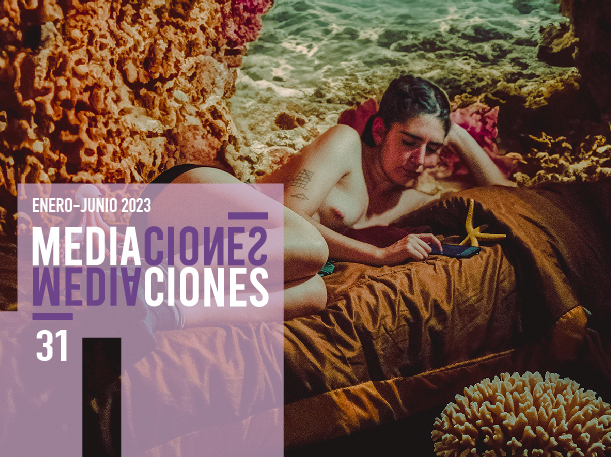Evidences, Transformations and Displacements of the Body in Dystopian Societies: A Reflection From the Artistic Production of Libia Posada
Article Sidebar

Downloads
How to Cite
Altmetrics
Article Details

This work is licensed under a Creative Commons Attribution 4.0 International License.
![]()
Revista MEDIACIONES © 2024 by Corporación Universitaria Minuto de Dios - UNIMINUTO is licensed under the Creative Commons BY.
Author Biography
María Cristina Caro, Universidad Nacional de Colombia
Filósofa egresada de la Universidad de La Salle, magíster en Historia del Arte, la Arquitectura y la Ciudad, de la Universidad Nacional de Colombia, candidata a doctora en Historia del Arte, la Arquitectura, docente de Historia del Arte de la Facultad de Artes, de la Universidad Nacional de Colombia.
Main Article Content
Abstract
The purpose of this writing is to present sections of the results obtained in the research process of my master's thesis entitled Lessons in female anatomy: A preliminary reading of the work of Libia Posada 1998-2014. I have grouped the results into three sections: A perverse target, Transformations and Displacements of the Body in Dystopian Societies and Sensitive Evidence. e conceptual axes that guide the development of the research are an introduction to the life and work of the artist; a description of her works in conceptual and formal terms, based on the methodologies of art history with a feminist perspective, and the development of reflections on the place of women in her artistic work. Axes that continually dialogue with an interview with the artist, which allows a greater approach and understanding of her work. The above is based on the hypothesis that experiencing life from a body configured as feminine, with a subjective experience, affects artistic production, making evident feminine elements or concerns, feminist or not, that may be characteristic in art made by women.
References
Beltrán, E., Maquieira, V., Álvarez, S. y Sánchez, C. (2001). Feminismos: Debates teóricos contemporáneos. Alianza.
Bruckner, J., Wolf, C., Bovenschen, S., Lenk, E., Weigel, S., Koch, G., Erlenmann, C., Rieger, E., Möhrmann, R., Breitling, G. y Göttner, H. (1986). Estética feminista. Icaria.
Cordero, K. y Sáenz, I. (Comp.) (2007). Crítica feminista en la teoría e historia del arte. Oak.
Espinel, N. (Enero-Junio, 2018). Moverse hacia el otro. Fuerzas, afectos y afectaciones en el cuidado y la responsabilidad por otros a través de la práctica artística, Errata, (19), 174-184. https://revistaerrata.gov.co/edicion/errata19-afectos-afectividades-y-afectaciones
Herrera, C. y Olaya, V. (2014). Fotografía y violencia: la memoria actuante de las imágenes. Cuadernos De Música, Artes Visuales Y Artes Escénicas, 9(2), 89–106. https://doi.org/10.11144/Javeriana.mavae9-2.fvma
Phelan, P. y Reckitt, H. (2005). Arte y feminismo. Phaidon.
Ramírez, E. (Enero-Junio, 2013). Libia Posada: Cartografías del sentir, Arte y diseño (11), 38-41.
Roca, J. y Suárez, S. (2012). Transpolítico arte en Colombia: 1992-2012. Lunwerg.
Sontag, S. (2010). Sobre la Fotografía. Random House Mondadori.
Picó, J. (Comp.). (1988). Modernidad y postmodernidad. Alianza.
Rodríguez, D. (2012). Obraviva. Banco de la República.
Rubiano, E. (2022). Los rostros, las tumbas y los rastros: El dolor de la guerra en el arte colombiano. Universidad Jorge Tadeo Lozano.
Similar Articles
- Joan Pedro-Carañana, Ángel Carrasco-Campos, Eliana Herrera-Huérfano, Thinking About Peace from Communication: From Johan Galtung's Culture of Peace to Communicative Justice , MEDIACIONES: Vol. 20 No. 32 (2024): January - June. COMMUNICATION, PEACE AND CITIZENSHIP
- Matheus Rodrigo Serafim Rodrigues, Disco Elysium: Memories of the End of History , MEDIACIONES: Vol. 21 No. 34 (2025): January - June. COMMUNICATION AND POWER
- T. Hazeena, Wildlife in the backyard: contemplating on human-wildlife interactions by community radio in South India , MEDIACIONES: Vol. 20 No. 33 (2024): July - December. COMMUNICATION AND SOCIAL CHANGE
- Lucía Benítez Eyzaguirre, Communication for social change: advances in gender, technology and social innovation (Morocco and Tunisia) , MEDIACIONES: Vol. 20 No. 33 (2024): July - December. COMMUNICATION AND SOCIAL CHANGE
- Bárbara Tomiatti Giancola, Miscellaneous on the reputation of NGOs in Spain and Latin America - Review of the book: Comunicación y tercer sector de acción social (Communication and the third sector of social action) , MEDIACIONES: Vol. 20 No. 33 (2024): July - December. COMMUNICATION AND SOCIAL CHANGE
- Marianela García, Feminist theologies and Women's Movements in Argentina: contributions to think about the construction of popular power , MEDIACIONES: Vol. 19 No. 31 (2023): July - December. COMMUNICATION, GENDER AND SEXUAL DIVERSITY
- María Laura Schaufler, Gender and Feminist Discourses in the Women's Web Press in Argentina. , MEDIACIONES: Vol. 19 No. 31 (2023): July - December. COMMUNICATION, GENDER AND SEXUAL DIVERSITY
- Romina Verrua, What do the Newspapers Say? (In)visibilities of the Creations of Former Uruguayan Female Political Prisoners on their Experiences of Repression during State Terrorism in the Press , MEDIACIONES: Vol. 19 No. 31 (2023): July - December. COMMUNICATION, GENDER AND SEXUAL DIVERSITY
- M. Cruz Tornay-Márquez, Interview with Tesh Sidi, Coordinator of the Saharawi Today Platform , MEDIACIONES: Vol. 19 No. 31 (2023): July - December. COMMUNICATION, GENDER AND SEXUAL DIVERSITY
- Maria Fernanda Molano Giraldo, Emilce Coy Pulido, Communication Strategies to promote Conflict Resolution Mechanisms from a Differentiated Perspective of Gender and Intersectionality , MEDIACIONES: Vol. 19 No. 31 (2023): July - December. COMMUNICATION, GENDER AND SEXUAL DIVERSITY
You may also start an advanced similarity search for this article.




